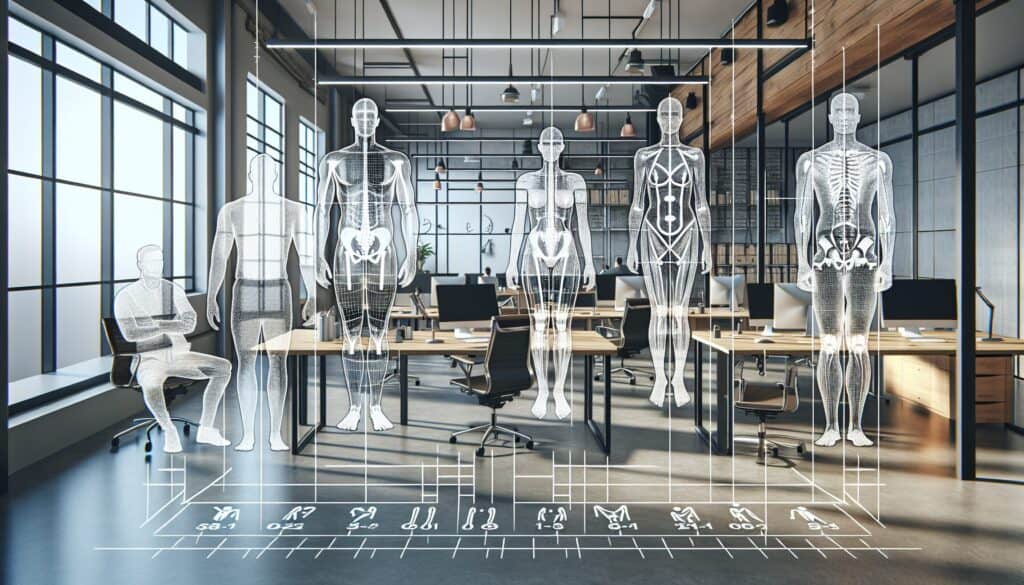Estudio de las medidas y proporciones del cuerpo humano para diseñar espacios de trabajo, equipos y productos que se adapten a los usuarios.
- Metodologías: Clientes y marketing, Ideación, Diseño de producto
Análisis antropométrico

Análisis antropométrico
- Diseño para fabricación aditiva (DfAM), Diseño para la fabricación (DfM), Optimización del diseño, Ergonomía, Human Factors, Diseño centrado en el ser humano, Usabilidad, Experiencia de usuario (UX), Diseño centrado en el usuario
Objetivo:
Cómo se utiliza:
- Consiste en utilizar los datos antropométricos (por ejemplo, altura, alcance, longitud de las extremidades) de la población de usuarios destinataria para garantizar que los diseños sean dimensionalmente compatibles con sus características físicas.
Ventajas
- Ayuda a diseñar productos y entornos cómodos, seguros y eficientes para la población destinataria; reduce el esfuerzo físico y los errores; puede mejorar la satisfacción del usuario.
Contras
- Los datos antropométricos varían en función de la población (edad, sexo, etnia) y deben estar actualizados; diseñar para un amplio abanico de usuarios (por ejemplo, del percentil 5 al 95) puede resultar complicado; las mediciones estáticas pueden no reflejar plenamente los requisitos de las tareas dinámicas.
Categorías:
- Ergonomía, Diseño de producto
Ideal para:
- Utilizar las medidas del cuerpo humano para diseñar espacios de trabajo, herramientas y productos que se adapten a los usuarios previstos.
Anthropometric Analysis applies extensively across various industries, including ergonomics, diseño industrial, and healthcare, facilitating the creation of tools, equipment, and workspaces that are inherently user-centric. This methodology is often employed during the early stages of product development, typically in user research and concept design phases, where understanding the physical characteristics of the target user population is pivotal. Participants in this process include product designers, engineers, ergonomists, and market researchers, who collaborate to gather and analyze anthropometric data relevant to their specific demographic. Industries such as automotive and aerospace rely heavily on this analysis, ensuring that vehicle interiors and control interfaces accommodate diverse user heights and body shapes, thereby enhancing safety and comfort. Similarly, in healthcare, ergonomic design of medical instruments and patient handling equipment is informed by anthropometric data, directly impacting healthcare outcomes through improved usability. The application extends to consumer products like furniture, where knowledge of human dimensions informs the ergonomic design of chairs and tables, ensuring that they can be used comfortably across a broad range of body sizes. This attention to anthropometric details not only reduces physical strain but also minimizes the risk of injury and errors during use, thereby enhancing operational efficiency and user satisfaction in multiple contexts.
Pasos clave de esta metodología
- Identify the target user population and their representative anthropometric data.
- Select relevant dimensions based on specific tasks or interactions required by the design.
- Analyze the distribution of the selected data to determine the design limits (minimum and maximum values).
- Create design envelopes that accommodate the diverse range of body sizes and shapes within the user population.
- Iterate design concepts based on ergonomics principles and user interface interactions.
- Prototype and evaluate designs with a sample of the target population for usability testing.
- Refine designs based on feedback and performance observations to enhance fit and comfort.
Consejos profesionales
- Incorporate segmental data to refine ergonomic assessments, focusing on the distribution of body proportions among different demographics.
- Utilize dynamic anthropometry by assessing movement patterns and workspace interactions to create adaptable designs that accommodate varying user scenarios.
- Implement iterative prototyping based on anthropometric data to validate design dimensions through user testing, ensuring comfort and functionality align with real-world applications.
Leer y comparar varias metodologías, recomendamos el
> Amplio repositorio de metodologías <
junto con otras más de 400 metodologías.
Sus comentarios sobre esta metodología o información adicional son bienvenidos en la dirección sección de comentarios ↓ , así como cualquier idea o enlace relacionado con la ingeniería.
Contexto histórico
1986
(si se desconoce la fecha o no es relevante, por ejemplo "mecánica de fluidos", se ofrece una estimación redondeada de su notable aparición)

Publicaciones relacionadas
Cuestionarios sobre molestias musculoesqueléticas
Pruebas multivariantes (MVT)
Análisis de regresión múltiple
Sistemas de captura de movimiento
Método MoSCoW
Prueba de la mediana de Mood